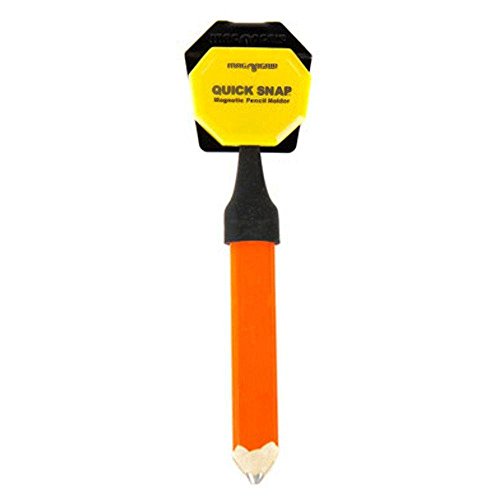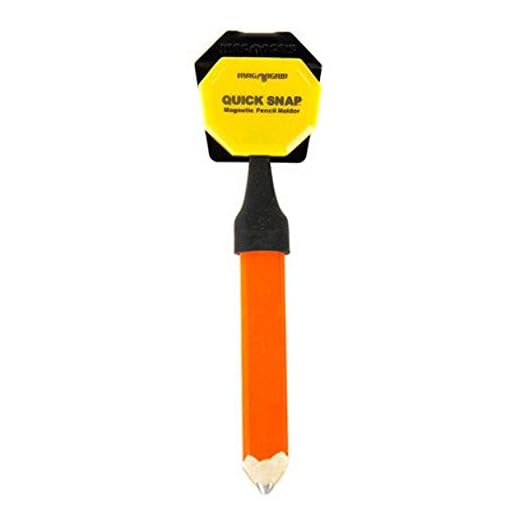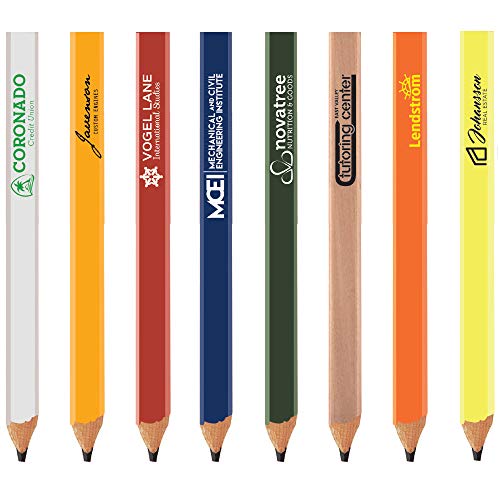






Have you ever wondered why a carpenter’s pencil is rectangular? While many pencils are cylindrical in shape, the carpenter’s pencil stands out due to its unique design. The rectangular shape of this pencil serves a specific purpose and offers several advantages that make it a preferred tool for carpenters and other professionals who require accurate and precise measurements.
The rectangular shape of a carpenter’s pencil allows it to stay in place when placed on a flat surface, preventing it from rolling away or falling off. This feature is particularly useful when carpenters need to make multiple marks or calculations in quick succession. Without the risk of rolling, carpenters can focus on their work without constantly chasing after a wayward pencil.
In addition to its stability, the rectangular shape of a carpenter’s pencil also allows for versatility. Unlike a standard pencil, the flat sides of a carpenter’s pencil can be used to draw both thick and thin lines, depending on the angle at which it is held. This allows carpenters to easily switch between marking out rough shapes and drawing precise lines, all with the same tool.
Furthermore, the flat shape of a carpenter’s pencil makes it easier to grip, providing a comfortable and secure hold for extended periods of use. This is especially important for carpenters who often work in challenging environments and need their tools to withstand demanding conditions.
In conclusion, the rectangular shape of a carpenter’s pencil offers stability, versatility, and ergonomic benefits that make it an indispensable tool for professionals in the carpentry industry. Its unique design ensures that it stays in place when needed, allows for multi-purpose usage, and provides a comfortable grip, making it a reliable and efficient choice for carpenters worldwide.
The Design and Functionality of Carpenter’s Pencils
When it comes to carpentry, having the right tools is essential for the job. One tool that is commonly seen in the hands of carpenters is the carpenter’s pencil. Unlike regular pencils, which are cylindrical, carpenter’s pencils have a unique rectangular design. Let’s explore the reasons behind this design choice and the functionality it offers.
Design
The rectangular design of a carpenter’s pencil serves several purposes. Firstly, it prevents the pencil from rolling off inclined surfaces, which is beneficial when working on uneven or sloped surfaces common in carpentry. The shape also makes it easier for carpenters to grip the pencil firmly, providing more control and precision when marking measurements and lines. The flat edges of the pencil allow for a more comfortable grip, reducing hand fatigue during long working hours.
Functionality
Carpenter’s pencils are specifically designed for use in woodworking and construction tasks. The flat shape of the pencil allows carpenters to easily draw straight lines along the edge of a ruler or carpenter’s square for accurate measurements. The wide lead, which is usually around 2-3 times thicker than a standard pencil lead, makes bold, visible marks that are easier to see on rough surfaces like lumber or concrete. This is especially important in outdoor or poorly lit environments where visibility may be limited. Additionally, some carpenter’s pencils have one flat side and one octagonal side, which allows for a quick and easy way to determine if the pencil has rolled and ensure consistent marking.
In conclusion, the rectangular design of a carpenter’s pencil offers practical advantages for carpentry work. Its shape prevents rolling, provides a comfortable grip, and allows for accurate measurements and markings. With its functionality and durability, it’s no wonder why carpenter’s pencils have become a staple tool for carpenters and woodworkers alike.
The Benefits of Using Carpenter’s Pencils
Carpenter’s pencils are a versatile tool that offer many benefits to professionals and DIY enthusiasts alike. Whether you are working on a construction project or completing a woodworking task, using a carpenter’s pencil can make the job easier and more efficient.
Durable and Long-lasting
One of the key benefits of using a carpenter’s pencil is its durability. Unlike regular pencils with a thin lead, carpenter’s pencils have a thicker, rectangular lead that can withstand heavy use and pressure. This makes them less prone to breakage and allows them to last longer, saving you time and money in the long run.
Easy to Sharpen and Use
Carpenter’s pencils are designed with a flat shape, which makes them easy to grip and prevents them from rolling away when placed on a sloped surface. Additionally, their flat lead allows for quick and easy sharpening with a knife or pencil sharpener. This feature ensures that you always have a sharp point for precise marking and accurate measurements.
Furthermore, carpenter’s pencils are designed to be used on rough surfaces like wood, concrete, or metal. The lead’s thickness and toughness make it less prone to breaking or wearing down, allowing you to make clear and visible markings even on textured materials.
Visible and Versatile Markings
Carpenter’s pencils typically have a lead color that contrasts well with most surfaces, making them highly visible even in low-light conditions. This visibility is crucial for accurate measurement and marking in construction and woodworking, where precision is of utmost importance.
In addition, the rectangular shape of the lead allows for different line widths. By adjusting the angle at which you hold the pencil, you can vary the thickness of the line, making carpenter’s pencils ideal for various applications, from rough framing to delicate finish work.
Markings that are Easy to Erase
When mistakes happen or adjustments need to be made, carpenter’s pencils offer the advantage of easy erasability. The graphite used in carpenter’s pencils is typically softer than that of regular pencils, allowing for smooth and complete erasing with an eraser or sandpaper.
Furthermore, the flat shape of the lead provides a larger erasing surface compared to standard cylindrical pencils. This makes it easier to remove markings without smudging or damaging the surrounding area.
In conclusion, carpenter’s pencils are not just your average pencil. Their durability, ease of use, versatility, and visibility make them an essential tool for any carpenter, construction worker, or DIY enthusiast. So next time you’re working on a project, consider reaching for a carpenter’s pencil and experience the difference for yourself.
The History and Evolution of Carpenter’s Pencils
Carpenter’s pencils have a long and fascinating history that dates back hundreds of years. These specialized pencils were designed with the needs of carpenters and other tradespeople in mind, providing a durable and practical tool for marking measurements and making precise markings on wood and other construction materials.
The earliest known carpenter’s pencils can be traced back to the 17th century. These early pencils were made from flat pieces of wood, usually rectangular in shape, with a groove or notch along one side. This groove held a strip of lead or graphite that could be easily replaced when worn down. The rectangular shape of the pencil prevented it from rolling off tables or scaffolding, making it a practical choice for carpenters working at heights or in challenging conditions.
Over time, carpenter’s pencils evolved to include additional features that enhanced their functionality. One such feature was the addition of a flat or oval-shaped design, which improved grip and prevented the pencil from rolling away. Another innovation was the introduction of softer and darker lead or graphite, making it easier for carpenters to create visible and long-lasting marks on various surfaces.
During the Industrial Revolution, the production of carpenter’s pencils became mechanized, allowing for mass production and increased availability. This led to the standardization of the pencil’s dimensions, with most carpenter’s pencils measuring around 1/2 inch wide by 1/4 inch thick.
In recent years, carpenter’s pencils have continued to evolve with the introduction of new materials and designs. Some pencils now feature a two-sided design with different degrees of hardness, allowing carpenters to switch between a softer lead for marking wood and a harder lead for marking other materials like metal or concrete.
Today, carpenter’s pencils remain a staple tool in the arsenal of carpenters and other tradespeople. Their unique rectangular shape, durability, and versatility make them an essential tool for precise marking and measurement in construction projects of all sizes.
The Different Types and Variations of Carpenter’s Pencils
Carpenter’s pencils are an essential tool for any carpenter or woodworker. These pencils are specifically designed for marking and measuring in woodworking projects. One of the key features of carpenter’s pencils is their rectangular shape, which sets them apart from traditional round pencils. This unique shape offers several advantages in woodworking.
Standard Carpenter’s Pencil: The most common type of carpenter’s pencil is the standard rectangular pencil. It has a flat shape that prevents the pencil from rolling off surfaces. This allows carpenters to keep their pencils close at hand without worrying about them falling and causing damage. The flat design also makes it easier to draw straight and accurate lines on wood surfaces.
Carpenter’s Pencil with Sharpener: Some carpenter’s pencils come with a built-in sharpener. This eliminates the need to carry a separate sharpener, making it convenient for carpenters on the go. The sharpener ensures that the pencil tip is always sharp, allowing for precise and fine lines when marking measurements or making notations on the wood.
Retractable Carpenter’s Pencil: Another variation is the retractable carpenter’s pencil. This type features a retractable mechanism that allows the lead to be extended or retracted as needed. This design prevents the lead from breaking when not in use and ensures that the pencil is always ready for use without the need for sharpening.
Carpenter’s Pencil with Clutch: Carpenter’s pencils with a clutch mechanism are also available. The clutch holds the lead firmly in place and allows for easy refills when the lead runs out. This type of pencil provides a consistent line thickness and is favored by carpenters who prefer a more traditional feel.
Overall, carpenter’s pencils come in various types and variations to cater to different needs and preferences of carpenters and woodworkers. Whether it’s the standard rectangular pencil, one with a built-in sharpener, a retractable design, or a pencil with a clutch mechanism, carpenter’s pencils offer durability, precision, and reliability in marking and measuring tasks in woodworking projects.
Tips for Choosing and Using Carpenter’s Pencils
Choosing the right carpenter’s pencil can greatly improve your woodworking efficiency and accuracy. Here are some tips to help you select and use these essential tools:
Consider the Lead Hardness
Carpenter’s pencils come with different lead hardness options, typically ranging from HB to 2B. HB pencils have medium hardness and are suitable for general carpentry tasks. 2B pencils have a softer lead, making them ideal for marking on rough surfaces or when precision isn’t as critical. Choose the lead hardness based on your specific project requirements.
Look for Durable Materials
When selecting a carpenter’s pencil, choose one made from durable materials. A graphite or composite pencil will last longer and resist breaking, ensuring it can withstand the rigors of construction work.
Additionally, consider pencils with an attached clip or built-in sharpener. These features can help keep your pencil safely secured and sharp when not in use.
Keep in mind that a rectangular-shaped carpenter’s pencil will not roll off inclined surfaces and is less likely to get lost or damaged compared to a round pencil.
Using a Carpenter’s Pencil Properly
When using a carpenter’s pencil, follow these best practices to achieve more accurate markings:
- Hold the pencil closer to the lead for better control and precision.
- Sharpen the lead with a utility knife or sharpener to maintain a fine point.
- Use the flat sides of the pencil to create straight lines or square corners.
- Rotate the pencil to maintain a sharp edge while reducing lead waste.
- Remember to test your markings on scrap materials before making permanent ones.
By choosing the right carpenter’s pencil and using it correctly, you’ll enhance your carpentry skills and achieve more accurate results in your projects.






